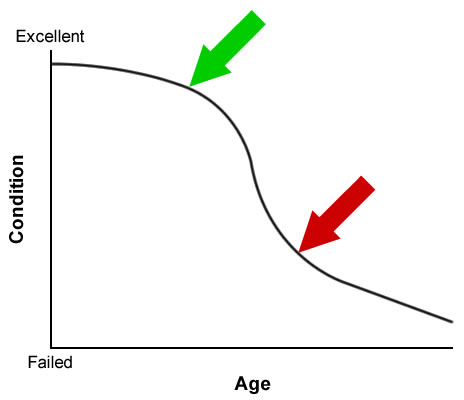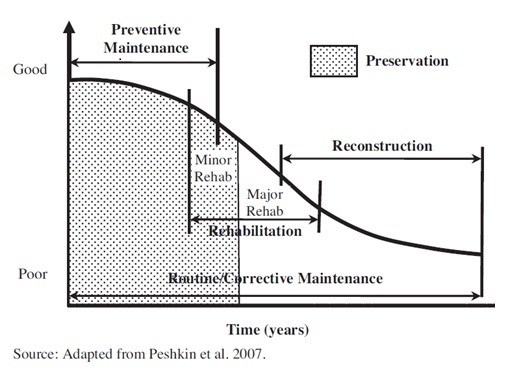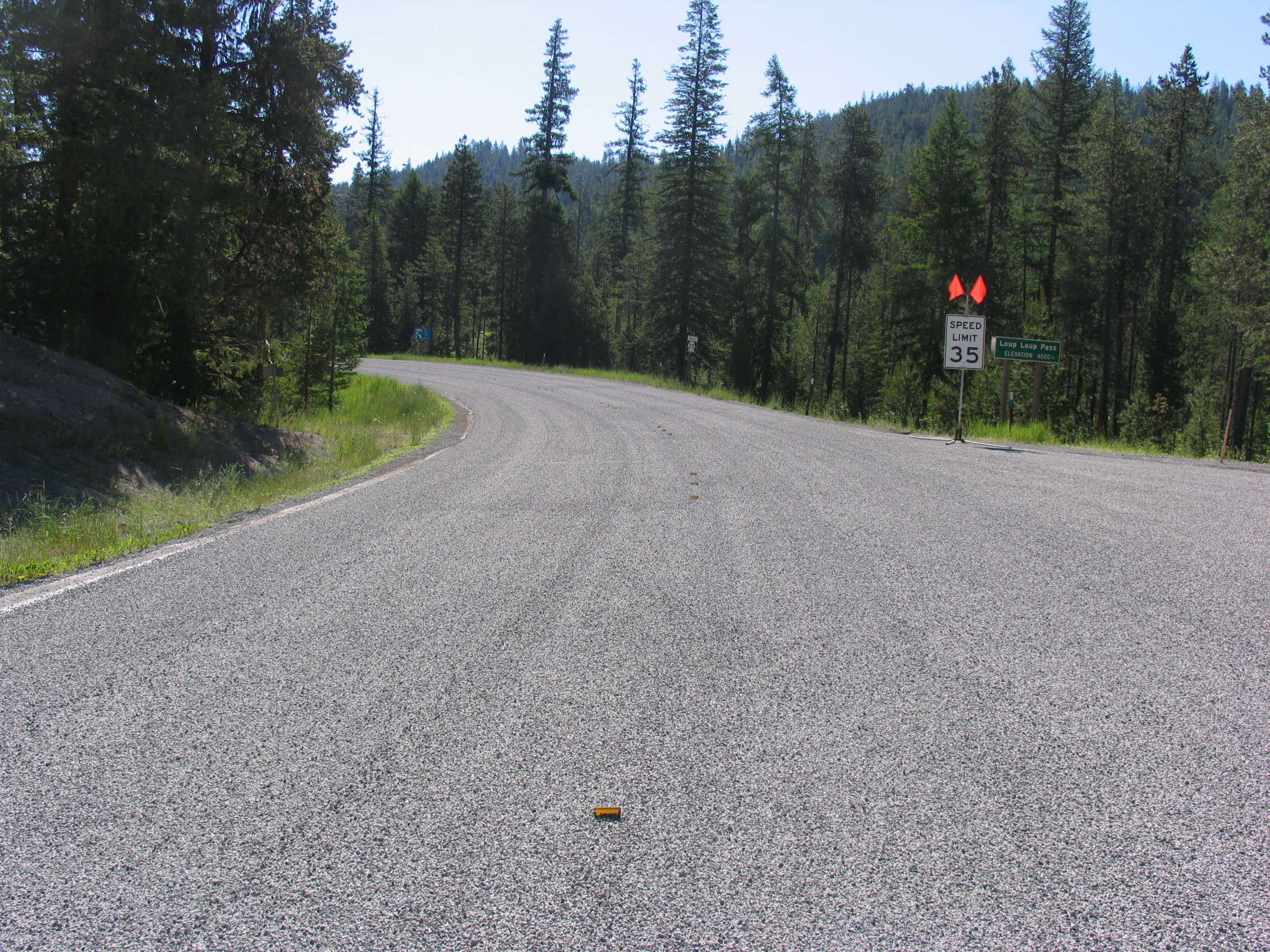The phrase “pavement maintenance” can mean a lot of things, ranging from simple cleaning or restriping up to fixing severe distresses like potholes and washouts. Maintenance can also involve different approaches, based on whether the emphasis is on repairing distresses or preventing them before they happen. In this edition of the RoadReady newsletter, we’ll explore the essential concept of pavement maintenance and the different types of activities that fit under this umbrella.
Maintenance Work and Pavement Life
One goal all maintenance activities have in common is extending the life of the pavement. Pavements are increasingly being designed for longer service lives, and longer-lasting pavements mean more opportunity for maintenance over the life of the pavement structure. To demonstrate the value of a long life pavement, it needs to show a lower life cycle cost than traditional alternatives, factoring in both the initial construction cost and ongoing maintenance over its functional life. In this approach, keeping pavement maintenance costs down is helpful to the success and viability of the design. That doesn’t necessarily mean that maintenance should be less frequent, but the maintenance activities must be cost-effective.
An important aspect for cost-effective maintenance over the pavement life cycle is the selection and timing of maintenance activities. Using the right maintenance treatment at the right time will help you get the maximum benefit. This depends partly on the condition of the pavement and where it is in its life cycle.

Under most circumstances, the condition of a pavement over time can be represented by a curve similar to the one shown above. The worse its condition gets, the more expensive the treatment required to restore the pavement to good condition, so you want to apply an appropriate treatment in the right general area on this curve. A relatively inexpensive preventive maintenance treatment earlier in the pavement’s life cycle, while it may only bring a slight improvement in the condition of the pavement, still makes a tremendous difference if you consider that it may postpone or avoid the need for a much more expensive treatment later on. Pavement management software is often used to estimate these curves and recommend when to apply maintenance treatments.
Categories of Pavement Maintenance
There are several categories of pavement maintenance activity, and the concept is also often discussed in connection with related topics, including pavement preservation, rehabilitation, and reconstruction. To better understand pavement maintenance, it helps to have an idea of how these terms are commonly used, otherwise they may seem overlapping and confusing. The following definitions are used by the Federal Highway Administration (FHWA):
Pavement preservation: Programs and activities employing a network level, long term strategy that enhances pavement performance by using an integrated, cost-effective set of practices that extend pavement life, improve safety, and meet road user expectations.
Pavement rehabilitation: Structural enhancements that extend the service life of an existing pavement and/or improve its load-carrying capacity.
Pavement reconstruction: Replacement of the entire existing pavement structure by the placement of the equivalent or increased pavement structure.

Pavement maintenance is normally distinguished from pavement rehabilitation, because maintenance treatments do not significantly change the structural or load-carrying capacity of the pavement. Preventive maintenance is one of the biggest components of a pavement preservation program, while other types of maintenance may not be considered preservation. Here are some definitions the FHWA uses for different categories of maintenance:
Preventive maintenance: A planned strategy of cost-effective treatments to an existing roadway system and its appurtenances that preserves the system, retards future deterioration, and maintains or improves the functional condition of the system (without significantly increasing the structural capacity).
Corrective maintenance: Activities performed in response to the development of a deficiency or deficiencies that negatively impact the safe, efficient operations of the facility and future integrity of the pavement section.
Routine maintenance: Work that is planned and performed on a routine basis to maintain and preserve the condition of the system or to respond to specific conditions and events that restore the system to an adequate level of service.

Preventive maintenance is most effective when a pavement is structurally sound and exhibits little or no distress. Examples of preventive maintenance activities include surface treatments such as chip seals or slurry seals, along with thin (non-structural) overlays. When pavement distress is already present, repairs in the form of corrective maintenance may be more appropriate. This includes treatments such as pothole repair and patching, along with joint replacement or slab replacement for rigid pavements. Smaller activities like cleaning roadside ditches or crack filling may be considered routine maintenance.
Prevention and Repair
Ideally, pavement maintenance would be mostly preventive, so that roads are always in good shape and distresses are never present. A well-planned maintenance program, in conjunction with a pavement management system, can help achieve this in a cost-effective way. At the same time, it’s wise to ensure that you have the capacity to make repairs when necessary. This will help you respond to unforeseen developments and maintain the structural integrity of the system. You might say that a complete pavement maintenance philosophy isn’t just about prevention or repair, it should cover both.
Additional Links
National Cooperative Highway Research Program, Report 523, Optimal Timing of Pavement Preventive Maintenance Treatment Applications: http://onlinepubs.trb.org/onlinepubs/nchrp/nchrp_rpt_523.pdf
Strategic Highway Research Program, SHRP 2 Report S2-R26-RR-2, Guidelines for the Preservation of High-Traffic-Volume Roadways: http://onlinepubs.trb.org/onlinepubs/shrp2/SHRP2-S2-R26-RR-2.pdf


Useful for me.
helps me alot
useful